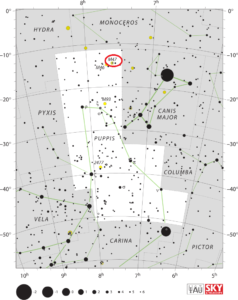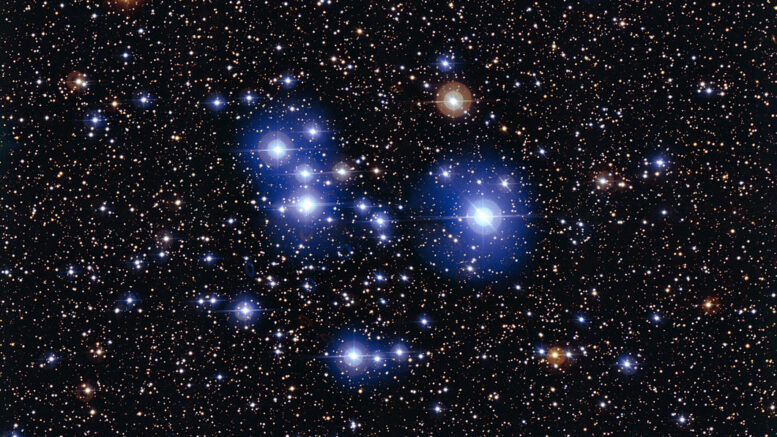Messier 47 is an open cluster in the constellation Puppis. It was discovered by Giovanni Batista Hodierna before 1654 and independently discovered by Charles Messier on February 19, 1771. It was later independently discovered again, under the current name NGC 2422. There is actually no cluster in the position indicated by Messier, which he expressed in terms of its right ascension and declination with respect to the star 2 Puppis. However, if the signs of Messier’s coordinate differences are changed, the position matches that of NGC 2422. Until the equivalency of M47 with NGC 2422 was found, M47 was considered a lost Messier Object. The discovery that M47 and NGC 2422 were the same cluster only came in 1959 with a realization by Canadian astronomer T. F. Morris.
| Description | |
| Visible From Pacific Northwest | November To March |
| Best Time To Observe | January and February |
| Minimum Size Of Viewing Device | 10×50 binoculars |
| Object Type | Open Cluster |
| Designations | Messier 47, M47, NGC 2422, Collinder 152, C 0734-143, OCl 596.0, MWSC 1278 |
| Right Ascension | 07h 36.6m |
| Declination | -14°30′ |
| Constellation | Puppis |
| Number Of Stars | 50 |
| Apparent magnitude | +4.2 |
| Apparent dimensions | 30′ |
| Object Radius | 6 light years |
| Distance From Earth | 1,600 light years |
History
Charles Messier independently discovered the cluster on February 19, 1771. He described it as a “cluster of stars, little distant from the preceding; the stars are greater; the middle of the cluster was compared with the same star, 2 Navis. The cluster contains no nebulosity.”
There is no cluster at the coordinates provided by Messier, but the position corresponds to that of the open cluster NGC 2422. M47 was considered a lost Messier object before the Canadian astronomer T. F. Morris discovered that Messier’s 47th catalogue entry and NGC 2422 were the same cluster. Morris also identified the missing Messier 48.
William Herschel discovered the cluster independently on February 4, 1785 and catalogued it as H VIII.38. He described it as a “cluster of pretty compressed large and small stars. Round. Above 15′ diameter.“
Locating M47 In The Sky
Messier 47 is quite easy to find as it is positioned 12 degrees to the east and 2 degrees to the north of Sirius, the brightest star in the sky, located in the constellation Canis Major. The cluster can also be found about 5 degrees south of Alpha Monocerotis, an orange giant in the constellation Monoceros, the Unicorn.

Viewing M47
The cluster is easily resolved in 10×50 binoculars, which reveal its brightest stars. Larger binoculars and small telescopes show many dimmer stars in M47, while 6-inch telescopes reveal a loose cluster with many bright and faint stars spread across an area 30 arc minutes in diameter.
Photographing M47
One can generate more visual interest by framing M46 with a short focal length telescope or camera lens. A single shot color camera or routine RBG imaging works best for open clusters. Luminance layering adds unneeded complexity for bright clusters. If telescope being used has imperfect color correction, refocus between filter changes to keep stars sharp. If a single shot color camera is being used, image close the meridian to reduce blur from atmospheric refraction at low altitudes. Processing requirements should be routine, with concentration focused on keeping star colors accurate.
Sources And Further Reading
Descriptions of all of Messier Objects can be found here.
https://freestarcharts.com/messier-47
https://www.messier.seds.org/m/m047.html

Be the first to comment on "Messier 47"